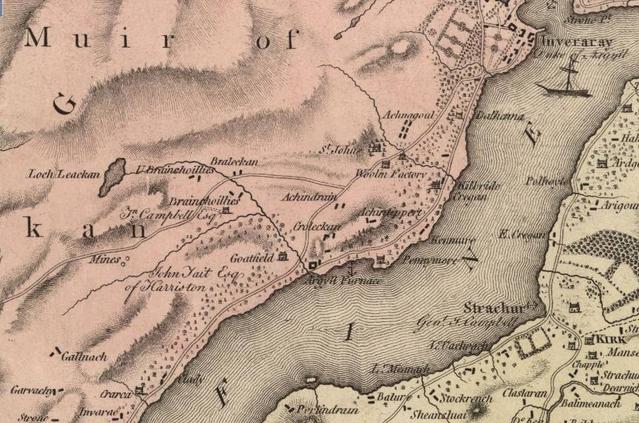
Furnace as a place name is not ancient on Loch Fyne, but the site at the mouth of the River Leacan was a strategic one in olden times. In the late 13th century the River Leacan was the border between two of Argyll’s great lordships, Lochow (Loch Awe) and Glassary.
The Campbell clan had only recently got a foothold in Argyll, and Sir Colin Campbell was a supporter of King Robert the Bruce, whose sister was his step mother. He was Lord of Lochow, and oversaw his lordship from his recently acquired castle of Innis Chonnal, on an island in Loch Awe. But even before his clan got a piece of Lochfyneside, his neighbour Master Ralph of Dundee, a man of the cloth in the service of King Alexander III from at least 1284, is recorded as having the lands of Glassary in 1292.
We don’t know why, or exactly when, Ralph received the lands of Glassary. Before his time they were in the possession of a family named MacGilchrist, so he may have married one of MacGilchrist’s daughters. What we do know is that the part of Glassary where our village stands was in the possession of Ralph’s descendants until 1668. Like the Lords of Lochow they oversaw their lands from a castle on Loch Awe; in their case Fincharn, near present-day Ford.
Ralph had died before 29th June 1312, when his son and heir John of Glassary received a grant of lands in Forfarshire. John had two sisters, Elizabeth and Margaret, and it is with Margaret of Glassary that our village first appears in history.
The first step is outlined in a charter in the Inveraray Castle Archives. There is no date on it, but it has been attributed to the year 1315, one year after the Battle of Bannockburn. This charter was given by John of Glassary to Dugald Campbell, believed to be the younger son of Sir Colin Campbell of Lochow, on his marriage to John’s sister, Margaret of Glassary. In it John grants Dugald and his wife one third of the lands of Glassary.
This Dugald rebelled against Robert the Bruce’s son, King David II, and by 1342 all his lands had been granted to his brother Archibald Campbell, Lord of Lochow. Dugald had no family by Margaret, but this did not stop the Campbells trying to get their hands on the third part promised as Margaret’s dowry.
On the 25th August, 1355, the eve of St Bartholomew’s Day, the interested parties met on the border of the two lordships to discuss the validity of the grant made forty years earlier. This meeting took place at Inverleacan (Inbhir Leacain – the mouth of the river, the site of our village). This document, called a Retour of Inquest, is still in existence too, and the name Inverleacan clearly defined.
In this document the Campbells claimed that John of Glassary, who was by now deceased, had been insane at the time of his sister’s marriage, and the lands should fall to the Campbells despite their being no children of the marriage. The claim was disputed, and the row was still going on seventy years later. It was taken up by John’s grand-daughter Agnes and her husband Alexander Scrymgeour (pronounced Scrim-ger), Constable of Dundee and grandson of William Wallace’s standard-bearer of the same name.
It seems strange that this part of Argyll should be for so long in the hands of east coast families, but the Scrymgeours held Glassary until the death of John Scrymgeour, 1st Earl of Dundee, in 1668.
